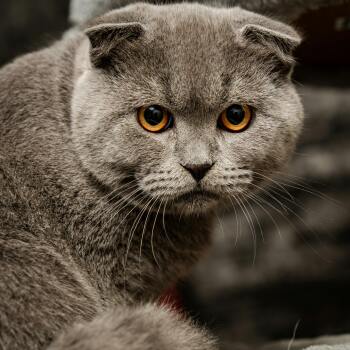Exotic Shorthairs

If you're lucky enough to share your home with one of these adorable furballs, you already know—they’re something special. Exotic Shorthairs are like little emotional barometers. They pick up on your moods, quietly keep you company, and win hearts with their soft purrs and even softer personalities.
So Much to Love
Exotics offer the best of both worlds: they have the calm, affectionate nature of a Persian, but with a short, plush coat that’s far easier to manage. They’re gentle, playful, great with kids and other pets, and come with a quiet, melodious meow that won’t interrupt your Zoom meetings. They’re affectionate without being demanding, loyal without being clingy, and have just enough quirky charm to keep you entertained.
A Little Clingy? Maybe.
While not dramatic attention-seekers, Exotic Shorthairs don’t love being left alone for long stretches. They thrive in homes with a consistent routine and plenty of love. And while their coat is easier than a Persian’s, it still needs regular brushing to stay clean and mat-free. Emotionally and physically, a little upkeep goes a long way.
So, is it worth it? Absolutely. Exotic Shorthairs are sweet, snuggly, and perfectly content just being near you. They’re the kind of companion who makes every day feel a little softer.
Where Did They Come From?
The Exotic Shorthair is what happens when breeders try to create a "Persian lite." Crossings between Persians and shorthaired breeds like the American and British Shorthair gave rise to the Exotic—a cat with Persian personality and a plusher, lower-maintenance coat. They were officially recognized as their own breed in 1967, and the rest, as they say, is history.
Whether you have a busy family or a quiet home, Exotic Shorthairs adapt beautifully. Just be ready for a little shadow who’d prefer you never leave the house.
Genetic Predispositions for Exotic Shorthairs
- Hypertrophic Cardiomyopathy (HCM)– This heart disease causes the heart muscle to thicken and can lead to fatigue, breathing issues, or even blood clots. Cats are pros at hiding illness, so if your Exotic seems tired or breathes faster than normal, don’t wait—schedule a check-up. Early diagnosis via ultrasound or chest X-ray can make all the difference.
- FATE (Feline Aortic Thromboembolism)– A scary but important one: blood clots can form in cats with heart disease and block blood flow to the hind legs. If your cat suddenly yowls in pain or can’t move their legs, it’s a veterinary emergency. Fast intervention and ongoing meds can help survivors regain full function.
- Brachycephalic Syndrome (Flat-Faced Breathing Problems)– That adorable smooshed face comes at a cost. Breathing issues, snoring, heat sensitivity, and even sleep apnea are common in brachycephalic breeds like the Exotic Shorthair. If your cat snores loudly or struggles in warm weather, talk to your vet. In severe cases, corrective surgery can improve quality of life.
- Cataracts– These cloudy lenses can lead to partial or full vision loss, especially in older cats. Many adjust well, but surgical options are available. Catching them early during routine exams is key.
- Eyelid Agenesis– A congenital defect where part of the upper eyelid doesn’t form correctly, causing chronic eye irritation. Surgery is often curative, giving your cat long-term relief and preventing future eye damage.
- FLUTD (Feline Lower Urinary Tract Disease)– Blood in the urine, straining, or urinating outside the litter box are red flags for urinary issues. Male cats can become blocked quickly, which is life-threatening. Diet changes, medication, or even surgery may be needed for chronic cases.
- Polycystic Kidney Disease (PKD)– Inherited from their Persian ancestors, this condition causes cysts to form in the kidneys, leading to gradual kidney failure. Symptoms often appear around age seven. Annual bloodwork and urine testing can help catch it early. While there’s no cure, special diets and meds can extend quality of life.
- Hip Dysplasia– Yep, it’s not just a dog thing! Exotic Shorthairs can develop hip dysplasia, leading to early arthritis and decreased mobility. X-rays at spay/neuter appointments can detect this early. Treatment may include pain meds or surgical options in severe cases.
- Portosystemic Shunt (PSS)– This liver condition causes toxins to bypass the liver and enter the bloodstream, leading to disorientation and drug sensitivity. Blood tests and ultrasound can diagnose it, and surgery may be recommended for long-term management.
- FIP (Feline Infectious Peritonitis)– A devastating disease caused by a mutated coronavirus, more common in Exotic Shorthairs. There’s no reliable screening test or cure, so choosing a reputable breeder and staying vigilant about early signs—like fluid buildup or lethargy—is crucial.
- FeLV (Feline Leukemia Virus)– This virus compromises the immune system and can cause cancer. Regular testing and vaccination are the best defenses, especially if you plan to introduce new cats to your home.
- Know Their Blood Type– Exotics may have less common blood types (like B or AB). A simple blood test can save time in an emergency if your cat ever needs a transfusion. It’s also vital for safe breeding.
- Neonatal Isoerythrolysis (NI)– If kittens with a different blood type nurse from a mother with incompatible milk, it can be fatal. If you’re breeding your Exotic, testing both parents for blood type can prevent tragedy.
- Separation Anxiety– If your cat seems depressed or destructive when you’re away, it could be stress. Puzzle feeders, window perches, or even feline pheromone sprays can help—and yes, sometimes even anti-anxiety meds.
- Dystocia (Difficult Labor)– Many Exotic Shorthairs require C-sections due to their compact body structure. If you’re considering breeding, work with a vet experienced in feline reproduction, and be prepared for medical costs and hands-on care.
Ready to Learn More? We’re Here to Help!


